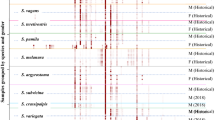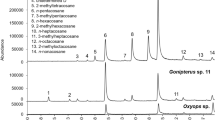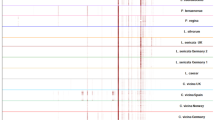Abstract
Blends of abundant cuticular hydrocarbons are species-specific for termites (Isoptera) and can be used to identify a given taxon without the diagnostic castes, soldiers or adults. We demonstrate that hydrocarbon extracts of termite fecal pellets from damaged wood can also be characterized and used to identify termites responsible for damage, even though termites are no longer present or easily recovered. In structures infested by drywood termites, it is common to find fecal pellets, but difficult to extract termites from the finished wood in service. Nine species belonging to two families (Kalotermitidae and Termopsidae) were examined to compare the hydrocarbon composition of termites and their fecal pellets. Diversity was extensive: at least one half of the amount of the hydrocarbons from Neotermes connexus, Incisitermes immigrans, Cryptotermes brevis, Cryptotermes cynocephalus, Procryptotermes corniceps, and Zootermopsis nevadensis nuttingi was olefins. Incisitermes minor and Pterotermes occidentis incorporated only small amounts of olefins in cuticular hydrocarbons; Marginitermes hubbardi had no detectable olefins. Hydrocarbons extracted from fecal pellets were qualitatively and quantitatively similar to cuticular extracts and can be used to determine the termite species responsible without the termites present.










Similar content being viewed by others
References
G. J. Blomquist D. R. Nelson M. Renobales Particlede (1987) ArticleTitleChemistry, biochemistry, and physiology of insect cuticular lipids Arch. Insect Biochem. Physiol. 6 227–265 Occurrence Handle10.1002/arch.940060404
W. V. Brown J. A. L. Watson M. J. Lacey (1994) ArticleTitleThe cuticular hydrocarbons of workers of three Australian Coptotermes species, C. michaelseni, C. brunneus and C. dreghorni (Isoptera: Rhinotermitidae) Sociobiology 23 277–291
W. V. Brown J. A. L. Watson M. J. Lacey (1996) ArticleTitleA chemosystematic survey using cuticular hydrocarbons of some species of the Australian harvester termite genus Drepanotermes (Isoptera: Termitidae) Sociobiology 27 199–221
R. F. Chapman K. E. Espelie G. A. Sword (1995) ArticleTitleUse of cuticular lipids in grasshopper taxonomy: A study of variation in Schistocerca shoshone (Thomas) Biochem. Syst. Ecol. 23 383–398 Occurrence Handle10.1016/0305-1978(95)00032-P
H. J. Child (1934) The internal anatomy of termites and the histology of the digestive tract C. A. Kofoid S. F. Light A. C. Horner M. Randall W. B. Herms E. E. Bowe (Eds) Termites and Termite Control EditionNumber2 University of California Press Berkeley, CA 58–88
J.-L. Clément A.-G. Bagnères P. Uva L. Wilfert A. Quintana J. Reinhard S. Dronnet (2001) ArticleTitleBiosystematics of Reticulitermes termites in Europe: Morphological, chemical and molecular data Insectes Soc. 48 202–215
M. S. Collins M. I. Haverty B. L. Thorne (1997) ArticleTitleThe termites (Isoptera: Kalotermitidae, Rhinotermitidae, Termitidae) of the British Virgin Islands: Distribution, moisture relations, and cuticular hydrocarbons Sociobiology 30 63–76
J. A. Coyne A. P. Crittenden K. Mah (1994) ArticleTitleGenetics of a pheromonal difference contributing to reproductive isolation in Drosophila Science 265 1461–1464 Occurrence Handle8073292
W. Ebeling (1975) Urban Entomology University of California Press Los Angeles
K. E. Espelie R. F. Chapman G. A. Sword (1994) ArticleTitleVariation in the surface lipids of the grasshopper, Schistocerca americana (Drury) Biochem. Syst. Ecol. 22 563–575 Occurrence Handle10.1016/0305-1978(94)90068-X
J. K. Grace R. J. Woodrow J. R. Yates (2002) ArticleTitleDistribution and management of termites in Hawaii Sociobiology 40 87–93
N. F. Hadley (1977) ArticleTitleEpicuticular lipids of the desert tenebrionid beetle, Eleodes armata: Seasonal and acclimatory effects on composition Insect Biochem. 7 277–283 Occurrence Handle10.1016/0020-1790(77)90025-7
N. F. Hadley (1981) ArticleTitleCuticular lipids of terrestrial plants and arthropods: A comparison of their structure, composition, and waterproofing function Biol. Rev. 56 23–47
N. F. Hadley (1985) The Adaptive Role of Lipids in Biological Systems John Wiley and Sons New York
M. I. Haverty L. J. Nelson (1997) ArticleTitleCuticular hydrocarbons of Reticulitermes (Isoptera: Rhinotermitidae) from northern California indicate undescribed species Comp. Biochem. Physiol. 118B 869–880
M. I. Haverty B. L. Thorne (1989) ArticleTitleAgonistic behavior correlated with hydrocarbonphenotypes in dampwood termites, Zootermopsis (Isoptera: Termopsidae) J. Insect Behav. 2 523–543 Occurrence Handle10.1007/BF01053352
M. I. Haverty M. Page L. J. Nelson G. J. Blomquist (1988) ArticleTitleCuticular hydrocarbons of dampwood termites, Zootermopsis: Intra- and intercolony variation and potential as taxonomic characters J. Chem. Ecol. 14 1035–1058 Occurrence Handle10.1007/BF01018791
M. I. Haverty B. T. Forschler L. J. Nelson (1996) ArticleTitleAn assessment of the taxonomy of Reticulitermes (Isoptera: Rhinotermitidae) from the southeastern United States based on cuticular hydrocarbons Sociobiology 28 287–318
M. I. Haverty B. L. Thorne L. J. Nelson (1996) ArticleTitleHydrocarbons of Nasutitermes acajutlae and comparison of methodologies for sampling cuticular hydrocarbons of Caribbean termites for taxonomic and ecological studies J. Chem. Ecol. 22 2081–2109 Occurrence Handle10.1007/BF02040096
M. I. Haverty M. S. Collins L. J. Nelson B. L. Thorne (1997) ArticleTitleCuticular hydrocarbons of termites of the British Virgin Islands J. Chem. Ecol. 23 927–964 Occurrence Handle10.1023/B:JOEC.0000006381.75185.86
M. I. Haverty L. J. Nelson B. T. Forschler (1999) ArticleTitleNew cuticular hydrocarbon phenotypes of Reticulitermes (Isoptera: Rhinotermitidae) from the United States Sociobiology 34 1–21
M. I. Haverty R. J. Woodrow L. J. Nelson J. K. Grace (2000) ArticleTitleCuticular hydrocarbons of termites of the Hawaiian Islands J. Chem. Ecol. 26 1167–1191 Occurrence Handle10.1023/A:1005479826651
R. W. Howard (1998) ArticleTitleOntogenetic, reproductive, and nutritional effects on the cuticular hydrocarbons of the host-specific ectoparasitoid Cephalonomia tarsalis (Hymenoptera: Bethylidae) Ann. Entomol. Soc. Am. 91 101–112
R. W. Howard B. L. Thorne S. C. Levings C. A. McDaniel (1988) ArticleTitleCuticular hydrocarbons as chemotaxonomic characters for Nasutitermes corniger (Motchulsky) and N. ephratae (Holmgren) (Isoptera: Termitidae) Ann. Entomol. Soc. Am. 81 395–399
M. Kaib R. Brandl R. K. N. Bagine (1991) ArticleTitleCuticular hydrocarbon profiles: A valuable tool in termite taxonomy Naturwissenschaften 78 176–179 Occurrence Handle10.1007/BF01136208
B. P. Moore (1969) Biochemical studies in termites K. Krishna F. M. Weesner (Eds) Biology of Termites, Vol. I Academic Press New York 407–432
H. B. Moore (1992) An Introduction to Wood Destroying Insects: Their Identification, Biology, Prevention, and Control Edgell Communications, Inc. Cleveland, OH
L. J. Nelson L. G. Cool B. T. Forschler M. I. Haverty (2001) ArticleTitleCorrespondence of soldier defense secretion mixtures with cuticular hydrocarbon phenotypes for chemotaxonomy of the termite genus Reticulitermes in North America J. Chem. Ecol. 27 1449–1479 Occurrence Handle10.1023/A:1010325511844 Occurrence Handle11504039
C. Noirot (1969) Glands and secretion K. Krishna F. M. Weesner (Eds) Biology of Termites, Vol. I. Academic Press New York 89–123
C. Noirot C. Noirot-Timothée (1969) The digestive system K. Krishna F. M. Weesner (Eds) Biology of Termites, Vol. I Academic Press New York 49–88
W. L. Nutting (1966) ArticleTitleDistribution and biology of the primitive dry-wood termite Pterotermes occidentis (Walker)(Kalotermitidae) Psyche 73 165–179
M. Page L. J. Nelson M. I. Haverty G. J. Blomquist (1990) ArticleTitleCuticular hydrocarbons of eight species of North American cone beetles, Conophthorus Hopkins J. Chem. Ecol. 16 1173–1198 Occurrence Handle10.1007/BF01021018
M. Page L. J. Nelson M. I. Haverty G. J. Blomquist (1990) ArticleTitleCuticular hydrocarbons as chemotaxonomic characters for bark beetles: Dendroctonus ponderosae, D. jeffreyi, D. brevicomis, and D. frontalis (Coleoptera: Scolytidae) Ann. Entomol. Soc. Am. 83 892–901
M. Page L. J. Nelson B. T. Forschler M. I. Haverty (2002) ArticleTitleCuticular hydrocarbons suggest three lineages in Reticulitermes (Isoptera: Rhinotermitidae) from North America Comp. Biochem. Physiol. 131B 305–324
R. E. Page R. A. Metcalf R. L. Metcalf E. H. Erickson SuffixJr. R. L. Lampman (1991) ArticleTitleExtractable hydrocarbons and kin recognition in honeybee (Apis mellifera L.) J. Chem. Ecol. 17 745–756 Occurrence Handle10.1007/BF00994197
J. G. Pomonis C. F. Fatland D. R. Nelson R. G. Zaylskie (1978) ArticleTitleInsect hydrocarbons. Corroboration of structure by synthesis and mass spectrometry of mono- and dimethylalkanes J. Chem. Ecol. 4 27–38 Occurrence Handle10.1007/BF00988257
R Development Core Team, 2004. A language and environment for statistical computing. R Foundation for Statistical Computing, Vienna, Austria. ISBN 3-900051-07-0, URL http://www.R-project.org.
W. S. Romoser J. G. Stoffolano SuffixJr. (1988) The Science of Entomology EditionNumber4 McGraw-Hill Boston, MA
C. Schal V. L. Sevala H. Young J. A. S. Bachmann (1998) ArticleTitleSynthesis and transport of hydrocarbons: Cuticle and ovary as target tissues Am. Zool. 38 382–393
R. H. Scheffrahn J. P. E. C. Darlington M. S. Collins J. Krecek N.-Y. Su (1994) ArticleTitleTermites (Isoptera: Kalotermitidae, Rhinotermitidae, Termitidae) of the West Indies Sociobiology 24 213–238
R. H. Scheffrahn N.-Y. Su J. A. Chase J. R. Mangold J. K. Grace J. R. Yates SuffixIII (2000) ArticleTitleFirst record of Cryptotermes cynocephalus Light (Isoptera: Kalotermitidae) and natural woodland infestations of C. brevis (Walker) on Oahu, Hawaiian Islands Proc. Hawaii. Entomol. Soc. 34 141–146
V. L. Sevala A.-G. Bagneres M. Kuenzli G. J. Blomquist C. Schal (2000) ArticleTitleCuticular hydrocarbons of the dampwood termite, Zootermopsis nevadensis: Caste differences and role of lipophorin in transport of hydrocarbons and hydrocarbon metabolites J. Chem. Ecol. 26 765–789 Occurrence Handle10.1023/A:1005440624678
R. E. Snodgrass (1935) Principles of Insect Morphology McGraw-Hill New York
L. Souto K. Kitayama (2000) ArticleTitleConstrictotermtes cyphergaster (Isoptera: Termitidae: Nasutitermitinae) maintain foraging trails for a longer period by means of fecal droplets Sociobiology 35 367–372
Y. Takematsu R. Yamaoka (1999) ArticleTitleCuticular hydrocarbons of Reticulitermes (Isoptera: Rhinotermitidae) in Japan and neighboring countries as chemotaxonomic characters Appl. Entomol. Zool. 3 179–188
B. L. Thorne M. I. Haverty (1989) ArticleTitleAccurate identification of Zootermopsis species (Isoptera: Termopsidae) based on a mandibular character of nonsoldier castes Ann. Entomol. Soc. Am. 82 262–266
B. L. Thorne M. I. Haverty M. Page W. L. Nutting (1993) ArticleTitleDistribution and biogeography of the North American termite genus Zootermopsis (Isoptera: Termopsidae) Ann. Entomol. Soc. Am. 86 532–544
E. C. Toolson R. Kuper-Simbrón (1989) ArticleTitleLaboratory evolution of epicuticular hydrocarbon composition and cuticular permeability in Drosophila pseudoobscura: Effects on sexual dimorphism and thermal-acclimation ability Evolution 43 468–473
J. A. L. Watson W. V. Brown L. R. Miller F. L. Carter M. J. Lacey (1989) ArticleTitleTaxonomy of Heterotermes (Isoptera: Rhinotermitidae) in southeastern Australia: Cuticular hydrocarbons of workers, and soldier and alate morphology Syst. Entomol. 14 299–325
F. M. Weesner (1970) Termites of the Nearctic Region K. Krishna F. M. Weesner (Eds) Biology of Termites, Vol. II Academic Press New York 477–525
R. J. Woodrow J. K. Grace L. J. Nelson M. I. Haverty (2000) ArticleTitleModification of cuticular hydrocarbons of Cryptotermes brevis (Isoptera: Kalotermitidae) in response to temperature and relative humidity Environ. Entomol. 29 1100–1107
E. C. Zimmerman (1948) Insects of Hawaii, Vol. 2 University of Hawaii Press Honolulu, HI
Acknowledgments
The authors thank C.H.M. Tome, R.J. Oshiro, S.Y. Uchima, and T.K. Brown for technical assistance and J.A. Baldwin for assistance with the cluster analysis. We extend thanks to Dr. and Mrs. H. Jarecki, J. Lazell, and the staff of the Guana Island Club for support and hospitality during the portion of this project conducted in the British Virgin Islands. This research was made possible, in part, by a grant to MIH by the Conservation Agency (through grants from the Falconwood Foundation), by a cooperative agreement between the University of Hawaii and the Pacific Southwest Research Station, by McIntire-Stennis funds for forestry research (J.K.G.), and by USDA-ARS Specific Cooperative Agreement 58-6615-4-237.
Author information
Authors and Affiliations
Corresponding author
Rights and permissions
About this article
Cite this article
Haverty, M.I., Woodrow, R.J., Nelson, L.J. et al. Identification of Termite Species by the Hydrocarbons in their Feces. J Chem Ecol 31, 2119–2151 (2005). https://doi.org/10.1007/s10886-005-6081-8
Received:
Revised:
Accepted:
Published:
Issue Date:
DOI: https://doi.org/10.1007/s10886-005-6081-8




